To grow rosemary in small spaces, start by choosing a container that’s 6-8 inches deep with drainage holes. Place it near a sunny south-facing window or outdoors in a sheltered spot where it can soak up 6-8 hours of sunlight daily. Use well-draining sandy or loamy soil to prevent root rot, and water deeply but infrequently. Prune regularly to encourage growth and keep it manageable. Stick around for more tips to ensure your rosemary thrives.
Key Takeaways
- Choose a container at least 6-8 inches deep with drainage holes to promote healthy root growth.
- Place your rosemary near a south-facing window for 6-8 hours of direct sunlight daily.
- Use a well-draining soil mix, combining potting soil with sand and perlite to mimic its natural habitat.
- Water deeply but infrequently, allowing the soil to dry out between watering sessions to prevent root rot.
- Regularly prune to encourage growth, trimming back one-third of the plant and harvesting leaves as needed.
Choosing the Right Container for Rosemary
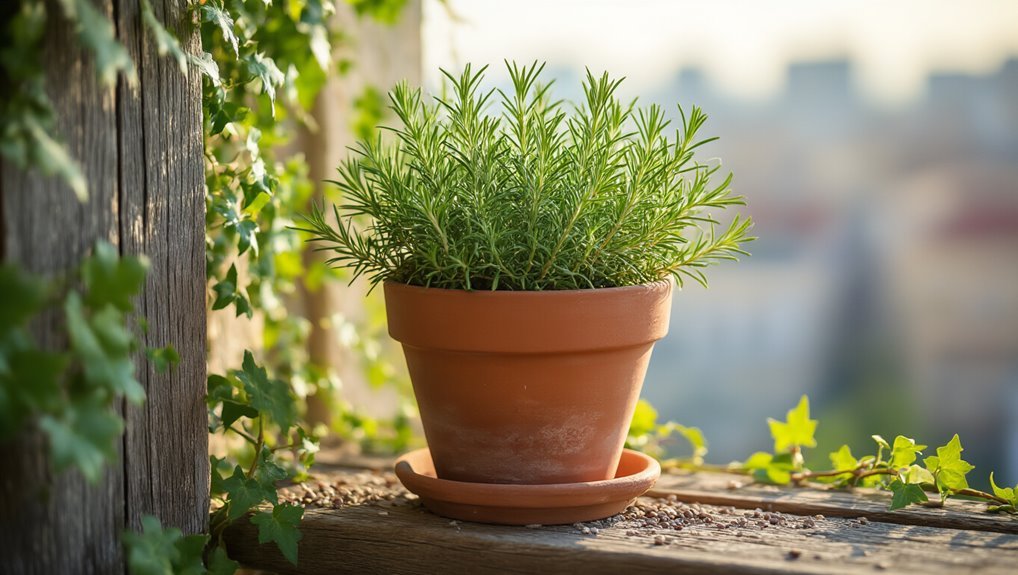
When you’re ready to grow rosemary, choosing the right container is essential for its health and growth.
Opt for a pot that’s at least 6 to 8 inches deep. Rosemary thrives in well-draining soil, so a container with drainage holes is crucial. Consider using terracotta or clay pots, as they allow for better airflow and moisture control. Just as you select the proper pot, don’t forget that garden hoses are invaluable for keeping your rosemary well-watered and healthy.
Ensure the container’s size allows for some root expansion since rosemary can grow quite large. If you’re short on space, a window box or hanging planter can also work.
Just remember to position it where it can soak up plenty of sunlight. With the right container, you’ll set your rosemary up for a thriving life. Happy planting!
If you want to elevate your indoor garden, explore beautiful plant pots that combine style with function for your rosemary and other herbs.
Selecting the Perfect Location
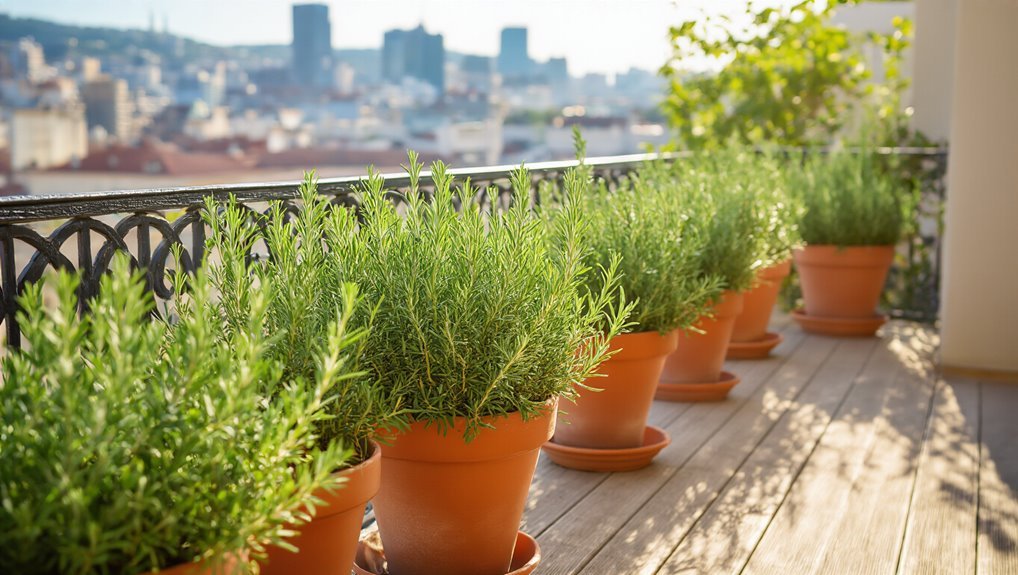
Since rosemary loves warm, sunny spots, selecting the perfect location for your plant is crucial for its success. Aim for a spot that receives at least six to eight hours of direct sunlight daily.
If you’re growing rosemary indoors, place it near a south-facing window where it can soak up the sun. Outdoors, choose a sheltered area that protects it from harsh winds while still allowing plenty of sunlight. Raised garden beds can be an excellent option for ensuring your rosemary gets optimal drainage and exposure, as raised garden beds help keep roots healthy and prevent waterlogging.
Avoid shady corners or areas with poor air circulation, as they can hinder growth. If you live in a cooler climate, consider moving your plant indoors during colder months to keep it thriving.
With the right location, your rosemary will flourish and provide you with abundant, aromatic leaves. For even more convenience, consider using indoor herb gardens designed to make growing rosemary and other herbs easy year-round.
Soil Requirements for Healthy Growth
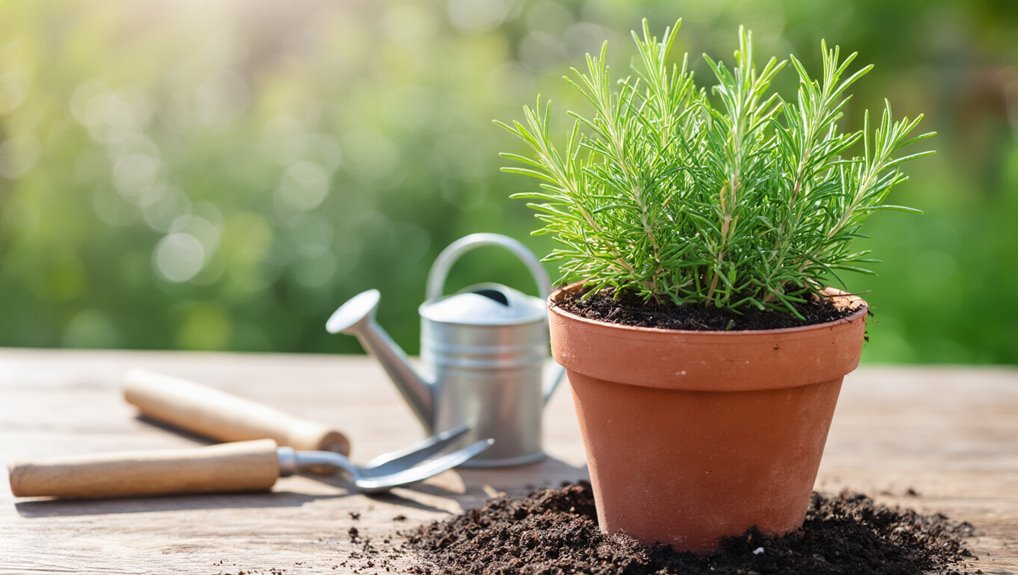
To ensure your rosemary thrives, you need to provide well-draining soil that mimics its native Mediterranean habitat. Aim for a sandy or loamy mix, as this allows excess moisture to escape and prevents root rot. You can create the perfect blend by combining potting soil with sand and perlite. For best results, consider using the best garden soil for thriving plants, as it offers the right balance of nutrients and drainage for healthy growth. Keeping your seeds organized with Garden Seed Storage Containers can also help ensure you always have fresh, viable seeds for each growing season.
| Soil Type | Characteristics | Benefits |
|---|---|---|
| Sandy Soil | Coarse texture | Excellent drainage |
| Loamy Soil | Balanced moisture | Nutrient-rich |
| Perlite | Lightweight, airy | Improves aeration |
Watering Tips for Optimal Hydration
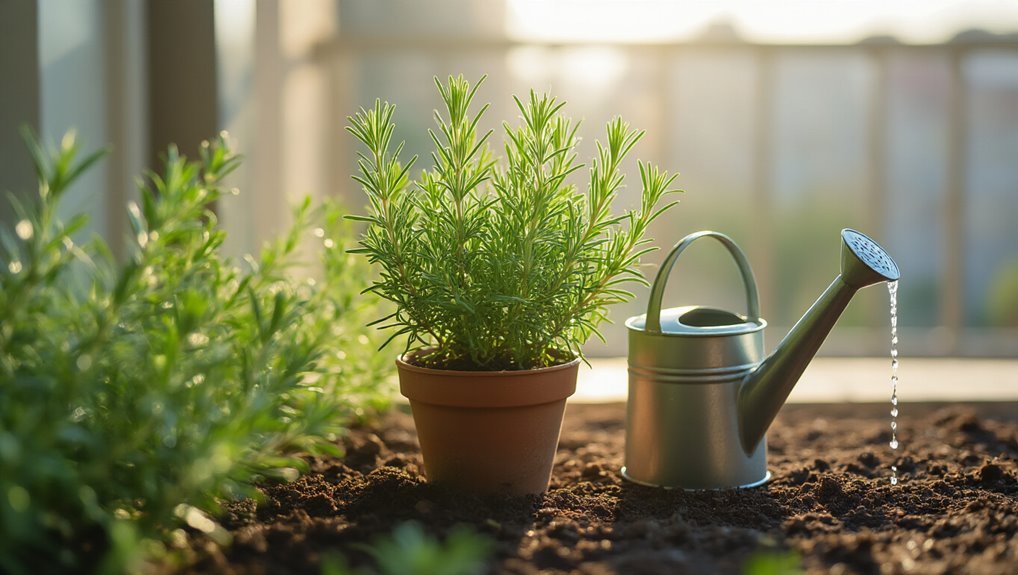
Providing the right soil is just the first step; proper watering is key to keeping your rosemary healthy. Rosemary thrives in well-drained soil, so be careful not to overwater. For added peace of mind, you can explore innovative watering systems designed to deliver consistent moisture without the risk of root rot. Check the top inch of soil; if it’s dry, it’s time to water.
Here are some tips to ensure optimal hydration:
- Water deeply but infrequently, allowing the soil to dry out between waterings.
- Use a watering can or drip system for better control, avoiding wetting the foliage.
- Observe your plant; if the leaves turn yellow, it might be getting too much water.
- For even more convenience, consider using Plant Watering Globes to help maintain consistent moisture levels in the soil, especially if you have a busy schedule or travel frequently.
Pruning and Harvesting Techniques
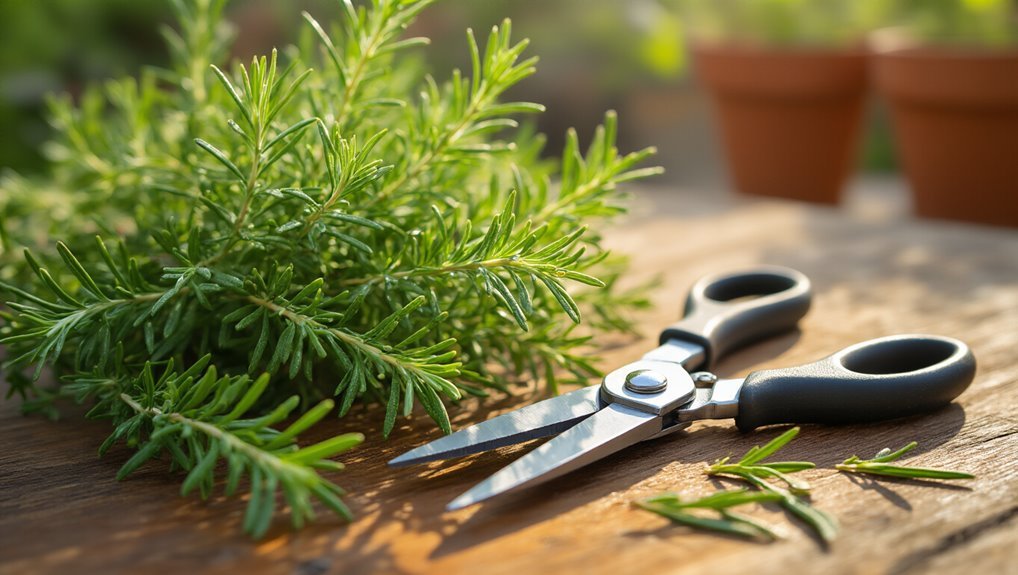
While rosemary can thrive with minimal intervention, regular pruning and proper harvesting techniques are essential for encouraging healthy growth and robust flavor.
Start by pruning your rosemary plant in early spring or late summer. Use sharp, clean shears to trim back about one-third of the plant, focusing on removing any dead or woody stems. This promotes bushier growth and prevents overcrowding. For even more effective maintenance in tight spaces, consider using a garden trowel to gently loosen soil around the base of your rosemary for improved aeration and root health.
When it comes to harvesting, pick leaves as needed, ensuring you take only what you’ll use. For larger harvests, cut stems just above a leaf node to encourage regrowth.
For best results, consider using pruning shears designed for precise and efficient cutting when tending to your rosemary plant.
Troubleshooting Common Rosemary Issues
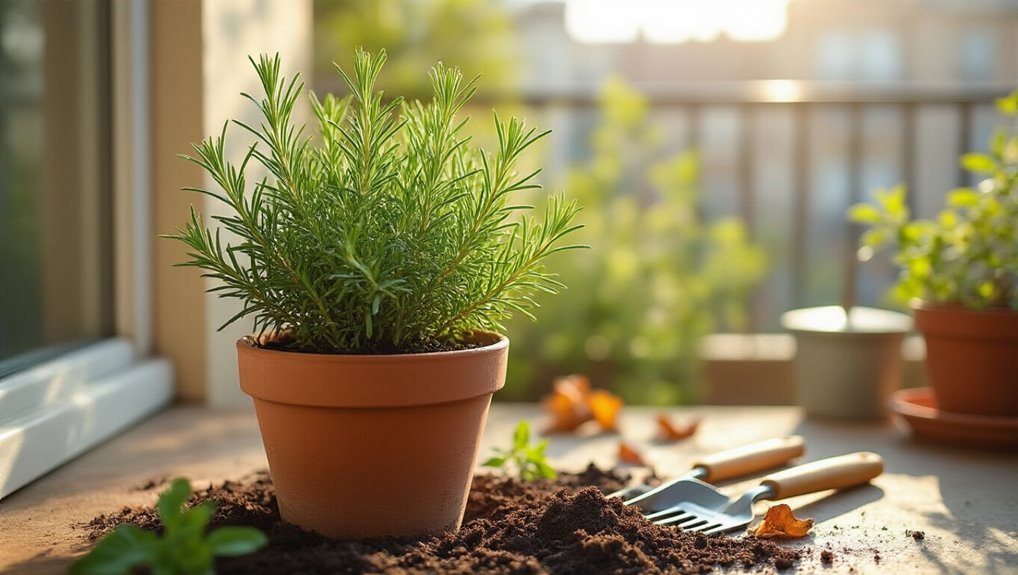
Have you noticed your rosemary plant showing signs of stress? Don’t worry; there are common issues you can troubleshoot easily.
Start by checking for overwatering, which can lead to root rot. Ensure your pot has good drainage and let the soil dry out between watering. For added protection, you can use garden pest traps to monitor or reduce unwanted insects near your rosemary.
Next, look for pests like spider mites or aphids. Regularly inspect the leaves and treat them with insecticidal soap if necessary.
Lastly, if your rosemary isn’t thriving, it mightn’t be getting enough sunlight. Aim for at least six hours of bright, direct light each day.
Remember to consider these factors:
- Watering habits
- Pest inspection
- Sunlight exposure
If pests persist, consider using effective solutions for pest control specifically designed for home gardeners to keep your rosemary healthy.
Frequently Asked Questions
Can I Grow Rosemary Indoors Year-Round?
Yes, you can grow rosemary indoors year-round! Just ensure it gets plenty of sunlight, ideally around six to eight hours a day. Water it moderately, and your rosemary will thrive beautifully in your home.
What Are the Best Companion Plants for Rosemary?
When considering companion plants for rosemary, think about plants that thrive together. Lavender enhances flavor, sage complements aroma, and thyme supports growth. These pairings not only boost health but also create a beautiful, fragrant garden.
How Long Does Rosemary Take to Grow From Seed?
Rosemary seeds typically take about two to three weeks to germinate. Once sprouted, it usually takes around 4 to 6 months for the plants to grow enough for you to start harvesting.
Is Rosemary Safe for Pets?
While rosemary’s fragrant leaves can delight your senses, they’re generally safe for pets. However, some animals might experience mild stomach upset. Always observe your furry friends closely when introducing new plants into their environment.
Can I Use Dried Rosemary for Propagation?
You can’t use dried rosemary for propagation. It’s best to use fresh cuttings from healthy plants. Dried herbs lack the necessary moisture and vitality needed for successful root development and growth.
Conclusion
With these easy rosemary growing tips, you can turn your small space into a fragrant herb haven. Remember, a little effort goes a long way—just like planting the seeds of success! Keep your rosemary well-watered, pruned, and in the right spot, and you’ll be rewarded with fresh flavors for your meals. Don’t hesitate to troubleshoot any issues that pop up; with a bit of care, your rosemary will thrive and bring joy to your cooking!


